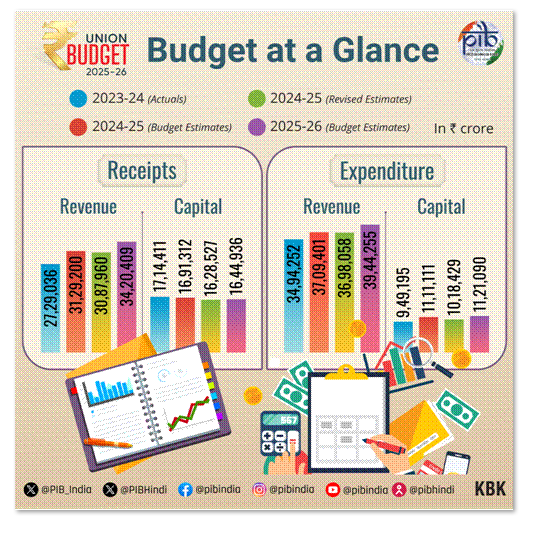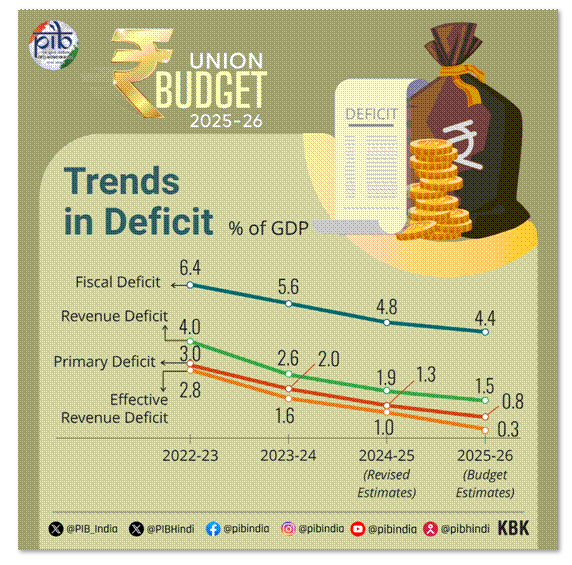
The Union Budget 2025-26 was presented in Parliament by Finance Minister Nirmala Sitharaman on February 1, 2025. The theme of Union Budget 2025 is “Sabka Vikas”. Union Budget 2025 identified four engines for boosting the economy, supporting the middle class, and driving industrial growth. Check details below. Given the importance of this topic, MBAUniverse.com presents GD Topic titled “Union Budget 2025: Key Highlights, Pros, Cons”.
Union Budget 2025: Key Highlights

Union Budget 2025 identified four engines for boosting the economy, supporting the middle class, and driving industrial growth. Read details below.
Union Budget 2025: 1st Engine - Agriculture
Budget announced ‘Prime Minister Dhan-Dhaanya Krishi Yojana’ in partnership with states covering 100 districts to increase productivity, adopt crop diversification, augment post-harvest storage, improve irrigation facilities, and facilitate availability of long-term and short-term credit. A comprehensive multi-sectoral ‘Rural Prosperity and Resilience’ programme will be launched in partnership with states to address underemployment in agriculture through skilling, investment, technology, and invigorating the rural economy. Union Finance Minister announced that Government will launch a 6-year “Mission for Aatmanirbharta in Pulses” with special focus on Tur, Urad and Masoor. The Budget has outlined measures to Comprehensive Programme for Vegetables & Fruits, National Mission on High Yielding Seeds, and a five year Mission for Cotton Productivity amongst other measures to promote agriculture and allied activities in a major way.
Union Budget 2025: 2nd Engine - MSMEs
Finance Minister described MSMEs as the second power engine for development as they constitute for 45% of our exports. To help MSMEs achieve higher efficiencies of scale, technological upgradation and better access to capital, the investment and turnover limits for classification of all MSMEs enhanced to 2.5 and 2 times, respectively. Further, steps to enhance credit availability with guarantee cover have also been announced.
The Finance Minister also announced the launch of a new scheme for 5 lakh women, Scheduled Castes and Scheduled Tribes first-time entrepreneurs. This will provide term loans up to Rs. 2 crore during the next 5 years.
Smt. Sitharaman announced that the Government will also implement a scheme to make India a global hub for toys representing the 'Made in India' brand. She added that the Government will set up a National Manufacturing Mission covering small, medium and large industries for furthering “Make in India”.
Union Budget 2025: 3rd Engine - Investments
Defining Investment as the third engine of growth, the Union Minister prioritized investment in people, economy and innovation. Under the investment in people, she announced that 50,000 Atal Tinkering Labs will be set up in Government schools in next 5 years. Five National Centres of Excellence for skilling will be set up with global expertise and partnerships to equip our youth with the skills required for “Make for India, Make for the World” manufacturing. A Centre of Excellence in Artificial Intelligence for education will be set up with a total outlay of 500 crore. Under the investment in Innovation, an allocation of ₹20,000 crore is announced to implement private sector driven Research, Development and Innovation initiative.
Union Budget 2025: 4th Engine - Exports
Smt. Sitharaman defined Exports as the fourth engine of growth and said that jointly driven by the Ministries of Commerce, MSME, and Finance; Export Promotion Mission will help MSMEs tap into the export market. She added that a digital public infrastructure, ‘BharatTradeNet’ (BTN) for international trade was proposed as a unified platform for trade documentation and financing solutions.
The Finance Minister mentioned that support will be provided to develop domestic manufacturing capacities for our economy’s integration with global supply chains. She also announced that government will support the domestic electronic equipment industry for leveraging the opportunities related to Industry 4.0. A National Framework has also been proposed for promoting Global Capability Centres in emerging tier 2 cities. The government will facilitate upgradation of infrastructure and warehousing for air cargo including high value perishable horticulture produce.
Union Budget 2025: Pros and Cons

In conclusion, Budget 2025 offers significant tax relief and incentives for consumption. However, reduced capex raises concerns about long-term economic growth.
Read key highlights of previous year budgets.
Union Budget 2024-2025: Schemes And Initiatives To Facilitate Employment, Skilling And Other Opportunities For Youth; Many Changes In Tax Laws
Key Highlights
Budget Day is an eagerly anticipated event in India, with both businesses and the general public waiting to understand the schemes and initiatives that could benefit them. This year, due to the elections, Budget 2024 has been announced later than usual i.e. February 1. The FM announced the Final Budget on 23rd July 2024. Here is a summary for the Latest GD Topics 2024 - UNION BUDGET 2024-2025.
The focus of the budget remains on four major groups: 'Garib' (Poor), 'Mahilayen' (Women), 'Yuva' (Youth), and 'Annadata' (Farmers) .
Priority 1: Productivity and Resilience in Agriculture:
Measures include releasing new 109 high-yielding crop varieties, promoting natural farming among 1 crore farmers, establishing 10,000 need-based bio-input bio-input centres, and enhancing production, storage, and marketing of pulses and oilseeds (achieve‘atmanirbharta’ for oil seeds).
Priority 2: Employment & Skilling:
The budget introduces schemes like Employment Linked Incentive and initiatives to boost skilling with a focus on skilling 20 lakh youth over a 5-year period and upgrading 1,000 Industrial Training Institutes.
Priority 3: Inclusive Human Resource Development and Social Justice:
Enhanced support for economic activities among marginalised groups, including tribal communities and women entrepreneurs, is emphasized.
The government's Purvodaya initiative aims to comprehensively develop the eastern region of India- including Bihar, Jharkhand, West Bengal, Odisha, and Andhra Pradesh, focusing on human resource development, infrastructure enhancement, and economic growth to advance towards a developed nation.
Priority 4: Manufacturing & Services:
The budget emphasises support for MSMEs, focusing on labour-intensive manufacturing, with a new self-financing guarantee fund offering up to Rs 100 crore per applicant.
Public sector banks will enhance their internal assessment capabilities for MSME credit. Additionally, Mudra loan limits will increase to Rs 20 lakh for previous 'Tarun' category borrowers.
Priority 5: Urban Development:
PM Awas Yojana Urban 2.0, has been allocated Rs 10 lakh crore to address housing needs of 1 crore urban poor and middle-class families, with Rs 2.2 lakh crore in central assistance over 5 years.
The government will also collaborate with State Governments and Multilateral Development Banks to promote water supply, sewage treatment, and solid waste management in 100 large cities through bankable projects.
Priority 7: Infrastructure:
Government will try to maintain strong fiscal support for infrastructure over the next 5 years on this line Rs 11,11,111 crore for capital expenditure has been allocated this year, which is 3.4% of our GDP.
Priority 8: Innovation, Research & Development:
The government will establish the Anusandhan National Research Fund to support basic research and prototype development, allocating Rs 1 lakh crore to spur private sector-driven research and innovation at a commercial scale.
Minister of Finance and Corporate Affairs Smt Nirmala Sitharaman, while presenting the Union Budget 2024-25 in Parliament said that India’s inflation continues to be low, stable and moving towards the 4 per cent target. Core inflation (non-food, non-fuel) currently is 3.1 per cent and steps are being taken to ensure supplies of perishable goods reach market adequately
Union Interim Budget 2024 – Prudence & Propriety or Lost Opportunity? – MBAUniverse.com Analysis
Indian Finance Minister Nirmala Sitharaman introduced the Interim Budget 2024 in Parliament on February 1, placing significant emphasis on India's macroeconomic growth and fiscal consolidation. As 2024 marks an election year, with Lok Sabha Elections anticipated in April-May, the finance minister chose to present an Interim Budget or a “Vote on Account” in February, rather than a complete Annual Budget. The anticipation is for the unveiling of the new full Budget in July 2024, post the establishment of the new government. However, some experts believe that since there are several months to go before the new government is formed, Interim Budget 2024 could have done a lot more to push the economy and business.
Given the paramount importance of the Government Budget for the Economy and Business, the analysis of Budget 2024 emerges as a crucial GD Topic for MBA Admission and other entrance exams. For a thorough exploration of Budget 2024 GD Topic, refer to this analysis on MBAUniverse.com.
GD Topic for MBA Admission – Union Interim Budget 2024
Conclusion
As India strides into a crucial election year, the Interim Budget 2024 sets the stage for economic resilience and progress. The fiscal projections, taxation strategies, and targeted initiatives for housing, healthcare, and renewable energy signify the government's commitment to a stable and flourishing economy. The upcoming months hold the promise of further financial insights and policies as the nation navigates through the democratic process and charts its course towards sustained growth.
However, some experts believe that since there are several months to go before the new government is formed, Interim Budget 2024 could have done a lot more to push the economy and business.
Latest 2024 GD Topics
Exam 2024 Notification